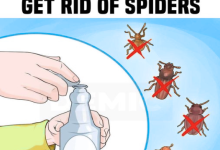Say goodbye to gross bacteria
The world can be quite the grimy place, with bacteria and viruses lurking everywhere you turn. So how to protect yourself from a world teaming with germs? Practicing cleanliness is the only way. Perhaps you’ve already adopted some clean habits such as avoiding touching public restroom door handles, sanitizing your hands after you get cash out at the ATM, or hitting elevator buttons with your elbow to minimize the number of bacteria with which you come into contact. But did you know that most of the germs you encounter won’t be found in public spaces but on some of the most commonly used surfaces in your own home? So what are the grossest spots in the house and, more importantly, how do you clean them? Read on to discover the 10 germiest places at home—some of which you may not suspect.
Kitchen Sponge
Stop! If you’re on after-dinner dish duty, you might want to think twice before reaching for your trusty kitchen sponge. According to a 2011 NSF household germ study, there’s an average of 321,629,869 microorganisms living in every gram of your used dish sponge. Yuck! To clean up your dish washing routine, clean your sponge each day. You can kill bacteria with heat by microwaving a damp sponge on high for one minute, or by soaking it in a solution of water and a small amount of bleach. Ultimately, to effectively combat grime you may need to replace your sponge more frequently. If you’d rather not pay to replace yours, switch to a dish rag and toss it in the wash frequently to zap germs.

Toothbrush Holder
Polishing your pearly whites is an important part of your hygiene routine, but the very cleaning tools you use to brush could be spreading more germs than they eliminate. One-third of the household toothbrush holders studied by NSF had Coliform present—an indication that fecal matter may be contaminating the surface. Scrub, scrub, scrub to restore your toothbrush holder to a sparkling clean. Let it sit in a cup of vinegar for about an hour, then thoroughly rinse and dry before returning toothbrushes to their proper place. Prevent recontamination by practicing good hand washing and storing your toothbrushes a safe distance from the commode.

Cutting Board
Though there’s some disagreement on which type of cutting board is more sanitary—wood or plastic—they all contain a lot of bacteria. According to Dr. Charles Gerba at the University of Arizona, there is 200 times more fecal bacteria on the average cutting board than a toilet seat—mostly from the raw meat you’ve been slicing and dicing. While you try to get that disturbing statistic out of your head, you can give your cutting board an extra scrub with good old-fashioned hot water and soap.

Kitchen Sink
The kitchen sink sees it all: raw chicken used coffee grinds, and mystery leftovers. Because of the large amount of cooking activity that happens in or around it, the sink can get pretty gross. The NSF found that sinks have a germ count of 31,905 microorganisms per 10 square centimeters—that’s 70,000 times more bacteria than what’s living on your toilet handle! To prevent bacteria from growing in the sink, sprinkle baking soda and wipe down with a vinegar-soaked paper towel or pull out the big guns by using a commercial disinfectant.

TV remote
Imagine the typical couch potatoes — watching TV while they absent-mindedly chew their fingernails, snack on food, and flip through channels, leaving all kinds of bacteria on the remote. “Anything in your home that you touch a lot leaves germs behind,” Rubino said. Make sure to sanitize the remote control regularly to prevent sickness.

Faucet Handles
Just like with countertops, make sure kitchen and bathroom faucet handles are cleaned regularly to avoid bacteria collection.

Bathroom
Unfortunately, some bacteria lingers in the bathroom after every use. To ensure that all types of coliform bacteria are controlled, pay particular attention to light switches, door knobs, and faucet handles. Keep some disposable disinfecting wipes handy for easy daily cleaning.
Bath towels and mats should be washed in hot water at least weekly and allowed to dry completely. Hand towels should be changed several times per week.
Bathroom sinks should be wiped down daily with disinfecting wipes and toothbrush holders and cups should be cleaned weekly.
When cleaning the obviously dirty areas of the bathtub, shower doors, and toilet, take time to wipe down flat surfaces like walls near toilets with disinfectant products.

The Dirty Places You Overlook
Let’s take a look at the dirtiest items you’ve overlooked in your home but need to be cleaned immediately:
- Pet Toys and Feeding Bowls
Your pet deserves nice clean food and water bowls. They should be washed daily in the dishwasher or by hand with hot soapy water, rinsed well and air dried to prevent harmful bacteria growth.
Pet toys can harbor coliform bacteria, yeast and mold. Hard toys should be cleaned with hot soapy water (at least weekly) and soft toys can be hand or machine washed using hot water and a disinfectant. - Keys, Purses, and Wallets
The items you handle every day pick up the germs and bacteria you’re exposed to every day as well. Take time to clean your key fobs, purses and wallets. Purses are usually the most germy. They land on the floor and then end up on counters and tabletops in your home. Keep fabric and leather handbags off the ground and clean them regularly–including the interior! - Backpacks and Gym Bags
Backpacks are a necessity for preschoolers to adults. Whether you carry camping equipment, work out clothes or books, eventually the backpack or your gym bag is going to need to be cleaned and disinfected.







